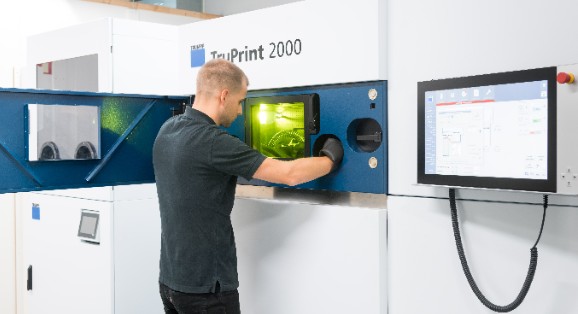Trumpf presents new TruPrint 2000 AM machine for medical devices
November 20, 2019

Trumpf unveiled its new metal Additive Manufacturing system, aimed at the medical device market, at Formnext 2019, Frankfurt, Germany. The TruPrint 2000 has been designed so that inert gas now flows through it back to front, a development said to enhance the quality of built parts.
In another new development, the operator can now remove excess powder from the component in the system rather than having to take it out and unpack it at a separate station, as in the past. This is easier and saves time when dealing with the smaller build chambers of machines like the TruPrint 2000. Metal powder is processed in an inert gas environment, preventing contaminants from infiltrating the powder circuit. This is a key advantage for sensitive medical devices and similar applications.
“With the TruPrint 2000, we are showing that Trumpf puts the needs of AM-focused industries first – that is, the aerospace, automotive, mechanical engineering, tool and mould making, and the medical and dental engineering industries. The TruPrint 2000 enables manufacturers to take advantages of Additive Manufacturing’s benefits – particularly medical and dental engineering companies,” commented Klaus Parey, managing director TRUMPF Additive Manufacturing.
The TruPrint 2000 is a multi-laser machine. Two 300 W lasers working in tandem illuminate the machine’s entire build chamber to boost the system’s productivity. Taking the same approach as used for the TruPrint 1000, Trumpf’s development engineers reportedly reduced the TruPrint 2000 laser’s focal diameter to 55 micrometers to build components with smoother surfaces, enhanced quality and intricate grid structures.
“The machine’s new design brings the benefits of lean manufacturing to users. It requires fewer add-ons, so the entry-level investment is lower for companies that want to get into AM,” commented Florian Krist, product manager at Trumpf Additive Manufacturing.
The machine also incorporates automated powder bed and melt pool quality monitoring. In the event of an error, the system notifies the operator, who can then take remedial action. Another benefit is an end-to-end documentation trail that corroborates the quality of the printing process, a key prerequisite for the Additive Manufacturing of medical devices.
Trumpf has already used the new machine to build a number of metal interbody cages, which are implanted to add stability to the spine. These can be inserted as a placeholder between two vertebrae to restore the vertebral segment’s natural height.
The laser’s small focal diameter is said to be ideal for fabricating the implants’ intricate structures, designed to aid osseointegration (bone in-growth). It is capable of producing nineteen implants in just twenty-four hours, and is also suitable for dental applications, as well as non-medical applications such as tool and mould-making.
















